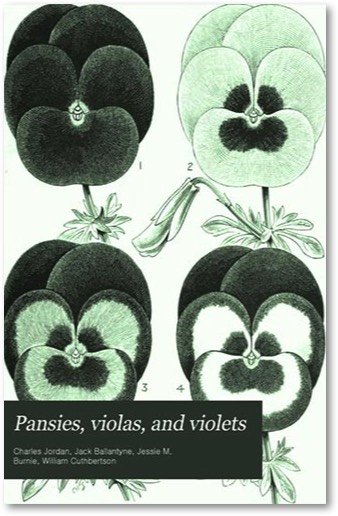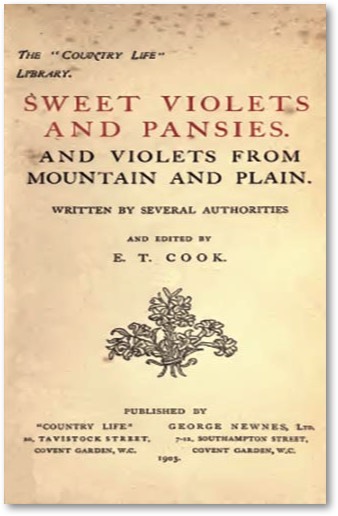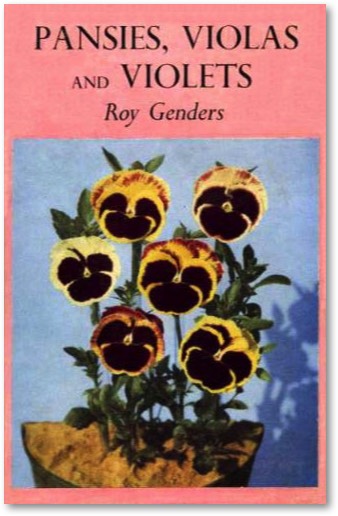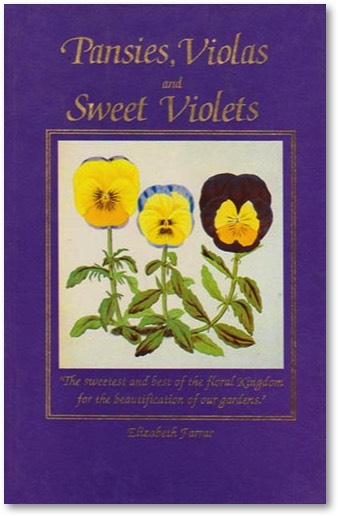
Musings » Pansies, Violas and Violets


Pansies, Violas and Violets
Charles Jordan, John Ballantyne, Jessie M. Burnie and William Cuthbertson
London, New York
Macmillan 1898
Charles Jordan, John Ballantyne, Jessie M. Burnie and William Cuthbertson
London, New York
Macmillan 1898

Sweet Violets and Pansies and Violets from Mountain and Plain
E. T. Cook
London
George Newness, Ltd. 1903
E. T. Cook
London
George Newness, Ltd. 1903

Pansies, Violas and Violets
Roy Genders
London
Garden Book Club 1958
Roy Genders
London
Garden Book Club 1958

Pansies Violas and Sweet Violets
Elizabeth Farrar
Berkshire
Hurst Village Publishing 1989
Elizabeth Farrar
Berkshire
Hurst Village Publishing 1989
Each of these four books is very small, not more than about 100 pages long but the fact that people keep writing about the flowers indicates a long and enduring interest. All the flowers known by these names are in the same genus, Viola , and are vey closely related. In many cases only experts can tell pansies and violas apart. They are charming unassuming little flowers which nevertheless have a powerful history of modification and cultivation. The early folk names tell the story: ‘Heartsease’, ‘Johnny Jump-ups’, “Shrinking Violets’, nothing fancy, all down home and unpretentious. They had markings on the petals and came in mixed colors, predominantly yellow, purple or light blue on a white or cream background. Violets have no markings on the petals.
We think of pansies now as border plants, useful for odd spaces and bedding out. It was not always so. The bedding out part is manmade, starting in 1813, two hundred year ago. The first steps to changing the pansy from a children’s wildflower to a gardener’s staple took place on a wealthy estate a few miles south of London. The story is that Admiral Lord Gambier, a retired sea captain, decided to collect a few heartsease on his property and handed them to his gardener, William Thompson, with instructions of improve them. As Thompson then unerringly crossed these wild flowers with specimens obtained from surrounding professional nurseries suggests to me that the gardener had already made plans and only maniulated things to make it look as though his master was in charge of the process. It was always wise to defer to the “quality” in those days. Thompson worked for almost 30 years and in 1841 wrote about his work in a horticultural publication of the time. The signature pattern of the modern Show or Fancy pansy (names used in the trade) is the dark blotch on the petals, something Thompson discovered and perpetuated by further breeding experiments. It was a serendipitous discovery. He looked down into the flower bed and saw what he thought was a “miniature cat’s face” staring up at him. This was the source of the modern pansy as we know it.
The action then moved to Belgium and France where more huge strides were made in form, colour and shape. They were not constrained by the rigid rules of British flower shows and could be more creative. Naturally enough in 1848 the new forms were imported back into England by an English nurseryman who had briefly owned a nursery in Versailles.
The outbreak of the 1848 Communist Revolution in France chased him back across the Channel. By 1851 John Salter was selling the new improved “Belgian” pansies at his Versailles Nursery in Hammersmith, London.
At roughly the same time James Grieve in Edinburgh solved the problem of making the pansy suitable for bedding. He bred what he called “Tufted Violas” in which the plants formed mats which could be easily split to propagate uniform layers of flowers and in which the blossoms were held well above the foliage.
There is great deal more to be told but this is enough to give you an idea of the humble little plant’s busy history.
We think of pansies now as border plants, useful for odd spaces and bedding out. It was not always so. The bedding out part is manmade, starting in 1813, two hundred year ago. The first steps to changing the pansy from a children’s wildflower to a gardener’s staple took place on a wealthy estate a few miles south of London. The story is that Admiral Lord Gambier, a retired sea captain, decided to collect a few heartsease on his property and handed them to his gardener, William Thompson, with instructions of improve them. As Thompson then unerringly crossed these wild flowers with specimens obtained from surrounding professional nurseries suggests to me that the gardener had already made plans and only maniulated things to make it look as though his master was in charge of the process. It was always wise to defer to the “quality” in those days. Thompson worked for almost 30 years and in 1841 wrote about his work in a horticultural publication of the time. The signature pattern of the modern Show or Fancy pansy (names used in the trade) is the dark blotch on the petals, something Thompson discovered and perpetuated by further breeding experiments. It was a serendipitous discovery. He looked down into the flower bed and saw what he thought was a “miniature cat’s face” staring up at him. This was the source of the modern pansy as we know it.
The action then moved to Belgium and France where more huge strides were made in form, colour and shape. They were not constrained by the rigid rules of British flower shows and could be more creative. Naturally enough in 1848 the new forms were imported back into England by an English nurseryman who had briefly owned a nursery in Versailles.
The outbreak of the 1848 Communist Revolution in France chased him back across the Channel. By 1851 John Salter was selling the new improved “Belgian” pansies at his Versailles Nursery in Hammersmith, London.
At roughly the same time James Grieve in Edinburgh solved the problem of making the pansy suitable for bedding. He bred what he called “Tufted Violas” in which the plants formed mats which could be easily split to propagate uniform layers of flowers and in which the blossoms were held well above the foliage.
There is great deal more to be told but this is enough to give you an idea of the humble little plant’s busy history.
Sweet Violets and Pansies and Violets from Mountain and Plain (1903) E .T. Cook
Pansies, Violas and Violets 1958 Roy Genders
Pansies Violas and Sweet Violets 1989 Elizabeth Farrar
Each of these four books is very small, not more than about 100 pages long but the fact that people keep writing about the flowers indicates a long and enduring interest. All the flowers known by these names are in the same genus, Viola , and are vey closely related. In many cases only experts can tell pansies and violas apart. They are charming unassuming little flowers which nevertheless have a powerful history of modification and cultivation. The early folk names tell the story: ‘Heartsease’, ‘Johnny Jump-ups’, “Shrinking Violets’, nothing fancy, all down home and unpretentious. They had markings on the petals and came in mixed colors, predominantly yellow, purple or light blue on a white or cream background. Violets have no markings on the petals.
We think of pansies now as border plants, useful for odd spaces and bedding out. It was not always so. The bedding out part is manmade, starting in 1813, two hundred year ago. The first steps to changing the pansy from a children’s wildflower to a gardener’s staple took place on a wealthy estate a few miles south of London. The story is that Admiral Lord Gambier, a retired sea captain, decided to collect a few heartsease on his property and handed them to his gardener, William Thompson, with instructions of improve them. As Thompson then unerringly crossed these wild flowers with specimens obtained from surrounding professional nurseries suggests to me that the gardener had already made plans and only maniulated things to make it look as though his master was in charge of the process. It was always wise to defer to the “quality” in those days. Thompson worked for almost 30 years and in 1841 wrote about his work in a horticultural publication of the time. The signature pattern of the modern Show or Fancy pansy (names used in the trade) is the dark blotch on the petals, something Thompson discovered and perpetuated by further breeding experiments. It was a serendipitous discovery. He looked down into the flower bed and saw what he thought was a “miniature cat’s face” staring up at him. This was the source of the modern pansy as we know it.
The action then moved to Belgium and France where more huge strides were made in form, colour and shape. They were not constrained by the rigid rules of British flower shows and could be more creative. Naturally enough in 1848 the new forms were imported back into England by an English nurseryman who had briefly owned a nursery in Versailles.
The outbreak of the 1848 Communist Revolution in France chased him back across the Channel. By 1851 John Salter was selling the new improved “Belgian” pansies at his Versailles Nursery in Hammersmith, London.
At roughly the same time James Grieve in Edinburgh solved the problem of making the pansy suitable for bedding. He bred what he called “Tufted Violas” in which the plants formed mats which could be easily split to propagate uniform layers of flowers and in which the blossoms were held well above the foliage.
There is great deal more to be told but this is enough to give you an idea of the humble little plant’s busy history.

